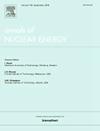Reprocessed fuels in a PWR SMR based on NuScale
IF 1.9
3区 工程技术
Q1 NUCLEAR SCIENCE & TECHNOLOGY
引用次数: 0
Abstract
This work evaluated reprocessed fuels in a core model based on a NuScale, a PWR Small Modular Reactor (SMR). With a model starting from the equilibrium core, this work suggests the replacement of fresh UO2 fuel with reprocessed fuels. It evaluated two types of reprocessed fuels: spiked with thorium and spiked with depleted U (0.2%). The main aim is to analyze the core burnup process with reprocessed fuels inserted in some assemblies and analyze the depleted spent fuel composition, multiplication factor during burnup, power distribution, leakage, and core activity. The core was modeled and simulated using the MC code SERPENT 2.2.1. As expected, the activity values for the models with reprocessed fuels are higher. The model with thorium has the highest activity and leakage. The keff s during burnup are higher for reprocessed fuels, which could lead to an extension of the burnup. The change in power distribution is minimal. It is necessary to advance the evaluation of reprocessed fuels to ensure a better destination for radioactive waste, as well as a better destination for depleted uranium. This material has shown promising results in reprocessed fuel analysis.
求助全文
约1分钟内获得全文
求助全文
来源期刊

Annals of Nuclear Energy
工程技术-核科学技术
CiteScore
4.30
自引率
21.10%
发文量
632
审稿时长
7.3 months
期刊介绍:
Annals of Nuclear Energy provides an international medium for the communication of original research, ideas and developments in all areas of the field of nuclear energy science and technology. Its scope embraces nuclear fuel reserves, fuel cycles and cost, materials, processing, system and component technology (fission only), design and optimization, direct conversion of nuclear energy sources, environmental control, reactor physics, heat transfer and fluid dynamics, structural analysis, fuel management, future developments, nuclear fuel and safety, nuclear aerosol, neutron physics, computer technology (both software and hardware), risk assessment, radioactive waste disposal and reactor thermal hydraulics. Papers submitted to Annals need to demonstrate a clear link to nuclear power generation/nuclear engineering. Papers which deal with pure nuclear physics, pure health physics, imaging, or attenuation and shielding properties of concretes and various geological materials are not within the scope of the journal. Also, papers that deal with policy or economics are not within the scope of the journal.
 求助内容:
求助内容: 应助结果提醒方式:
应助结果提醒方式:


